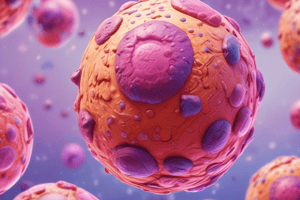Podcast
Questions and Answers
What is the most common type of malignant melanoma?
What is the most common type of malignant melanoma?
- Superficial spreading (correct)
- Lentigo maligna
- Acral lentiginous
- Nodular
Seborrheic keratosis is a type of malignant neoplasm.
Seborrheic keratosis is a type of malignant neoplasm.
False (B)
What type of cancer is primarily associated with basal cells?
What type of cancer is primarily associated with basal cells?
Basal cell carcinoma
The primary tumor site for acral lentiginous melanoma is on the _____ and nails.
The primary tumor site for acral lentiginous melanoma is on the _____ and nails.
Match the following benign neoplasms with their descriptions:
Match the following benign neoplasms with their descriptions:
Which of the following is a risk factor for developing malignant melanoma?
Which of the following is a risk factor for developing malignant melanoma?
Only older adults can be diagnosed with nodular melanoma.
Only older adults can be diagnosed with nodular melanoma.
What is the recommended treatment for morpheaform nevi?
What is the recommended treatment for morpheaform nevi?
The clinical presentation of a nodular melanoma includes a bluish, _____ nodule that may ulcerate.
The clinical presentation of a nodular melanoma includes a bluish, _____ nodule that may ulcerate.
What is a key characteristic of superficial melanoma?
What is a key characteristic of superficial melanoma?
Flashcards
Nevi
Nevi
Benign growths formed from melanocytes, can be congenital or acquired.
Seborrheic Keratosis
Seborrheic Keratosis
Common non-cancerous skin growths, often brown or black, scaly appearance.
Malignant Melanoma
Malignant Melanoma
A type of skin cancer arising from melanocytes, potentially life-threatening.
Superficial Spreading Melanoma
Superficial Spreading Melanoma
Signup and view all the flashcards
Nodular Melanoma
Nodular Melanoma
Signup and view all the flashcards
Acral Lentiginous Melanoma
Acral Lentiginous Melanoma
Signup and view all the flashcards
Keloid
Keloid
Signup and view all the flashcards
Dermatofibroma
Dermatofibroma
Signup and view all the flashcards
Epidermal Inclusion Cyst
Epidermal Inclusion Cyst
Signup and view all the flashcards
Cherry Hemangioma
Cherry Hemangioma
Signup and view all the flashcards
Study Notes
Benign Neoplasms in Practice
-
Nevi (Melanocytic Nevi): Benign, even color and distribution. Biopsy if appearance changes. Composed of melanocytes. Usually less than 1 cm, tan to brown. Can be symptomatic (itching, bleeding, etc.). Considered normal unless clinically atypical, irritated, or cosmetic concerns.
-
Seborrheic Keratosis: Common benign tumor in those over 40. Appearance "stuck on", various colors (pale brown to dark brown). Velvet or verrucous texture. Often not a concern unless irritated.
-
Solar Lentigo: Benign, sun-induced lesion (liver spots). Pigmented (yellow, brown, or black), flat or slightly raised, typically found on sun-exposed areas.
-
Verruca Vulgaris (Warts): Viral infection, common on hands and knees. Rough, hyperkeratotic surface.
-
Epidermal Inclusion Cyst: Most common cutaneous cyst. Flesh-colored nodule, firm, central pore. Often asymptomatic, can discharge foul-smelling material.
-
Cherry Hemangioma: Common vascular proliferation with age. Small red macules or papules, can sometimes be violet. May bleed with trauma. Not usually a concern unless bothersome or indicative of another condition.
-
Acrochordon (Skin Tag): Small, soft, pedunculated papules. Often found in areas of friction (neck, axillae, groin). May fall off spontaneously. Usually not a concern unless bothersome.
-
Sebaceous Hyperplasia: Overgrowth of sebaceous glands, common in older age. Associated with oily skin.
-
Dermatofibroma: Unknown etiology, often forms in scar tissue or following trauma. Firm, pea-sized nodule, usually asymptomatic except if irritated.
-
Milia: Keratin-filled cysts, common in infants and adults. Small, pearly, superficial lesions, usually on the face.
-
Stucco Keratosis: Thickening of epidermis, most common in men, appears after age 40, "stuck on" appearance. Usually asymptomatic, white or yellowish.
-
Fibrous Papule: Relatively common benign papule found often on the face, around nose and mouth, in those 20-30 years of age.
-
Keloid and Hypertrophic Scars: Overgrowth of scar tissue. Keloids expand beyond the injury, whereas hypertrophic stay within the original wound.
-
Lipoma: Benign fatty tumor. Soft, firm, usually painless, and easily movable.
Atypical Mole (Dysplastic Nevus)
-
Background: Clinical and histologic definitions are controversial, potentially inherited or acquired throughout lifetime, require monitoring.
-
Presentation: Exhibits ABCDE criteria (asymmetry, border irregularity, color variation, diameter>6mm, evolving/enlarging). Frequently on sun-exposed areas.
-
History: Personal and family history of melanoma, sun exposure.
-
Differentials: Malignant melanoma, melanocytic nevus, seborrheic keratosis.
-
Treatment: Full body exam, patient counseling, photography, monitoring for progression. Surgical shave biopsy, excision with margins.
Studying That Suits You
Use AI to generate personalized quizzes and flashcards to suit your learning preferences.




